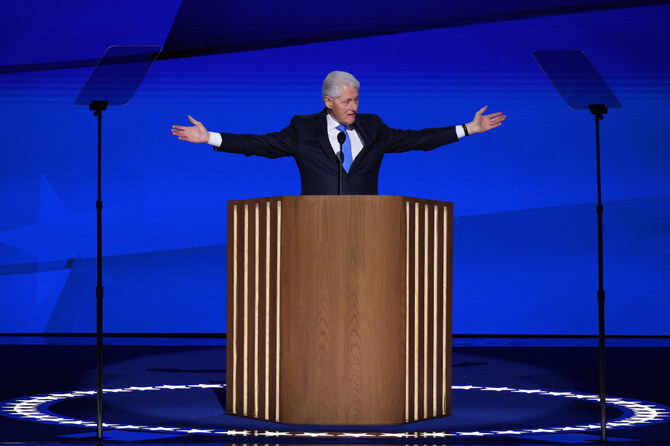CHICAGO: Former President Bill Clinton returned to the Democratic National Convention stage to denounce Donald Trump as selfish and praise Kamala Harris as focused on the needs of Americans, giving another of his emblematic, off-the-cuff addresses.
Clinton said November’s election would be “‘We The People’ versus ‘Me, Myself and I,’” firing up Wednesday’s third night of the DNC before vice presidential nominee Tim Walz got the chance to introduce himself to a national audience.
Democrats are hoping to build on the momentum that Vice President Kamala Harris has brought since taking over the top of the party’s presidential ticket last month. They want to harness the exuberance that has swept over their party since President Joe Biden stepped aside while also making clear to their supporters that they face a fierce battle with Republicans and former President Donald Trump.
Clinton, the nation’s 42nd president and a veteran of his party’s political convention going back decades, was once declared the “secretary of explaining stuff” by Barack Obama, whose reelection bid in 2012 was bolstered by a Clinton stemwinder at that year’s DNC. Now 78 — the same age as Trump — Clinton’s delivery was sometimes halting and his movements slower, but he delivered homespun lines about the election and urged Democrats to back Harris.
“What does her opponent do with his voice? He mostly talks about himself,” Clinton said. “So the next time you hear him, don’t count the lies, count the I’s.”

Former US President Bill Clinton takes the stage on Day 3 of the Democratic National Convention at the United Center in Chicago, Illinois, on August 21, 2024. (REUTERS)
Clinton also said he was glad to have “a coach on our team,” warming up for Walz, the Minnesota governor who has become known among supporters as a folksy, Midwestern teacher, football coach and dad. He’s also been the target of Republican criticism over how he’s portrayed his National Guard service and his personal story.
Organizers dubbed the night “a fight for our freedoms,” with the programming focusing on abortion access and other rights that Democrats want to center in their campaign against Trump. Speaker after speaker argued that their party wants to defend freedoms — especially abortion access and voting rights — while Republicans want to take them away.
Colorado Gov. Jared Polis used a prop that has become a staple at the convention, an oversized book meant to represent the Heritage Foundation’s Project 2025, a sweeping set of goals to shrink government and push it to the right, if Trump wins. Polis even ripped a page from the ceremonial volume and said he was going to keep it and show it to undecided voters.
The former president has distanced himself from Project 2025, but its key authors include his former top advisers. His running mate, JD Vance, wrote the foreword for the Heritage Foundation CEO’s new book.
The oversized Project 2025 book returned for an appearance with comedian Kenan Thompson, who joked of the prop’s heft, “You ever seen a document that could kill a small animal and democracy at the same time?”
Florida Rep. Debbie Wasserman Schultz told the story of a woman in her state, which enacted new abortion restrictions after the Supreme Court overturned Roe v. Wade, who was forced to carry to term a child with a fatal illness, only to watch the newborn die just hours after birth.
Dana Nessel, Michigan’s attorney general and an openly gay woman, declared, “I got a message for the Republicans and the justices of the US Supreme Court: You can pry this wedding band from my cold, dead, gay hand.”
And Stevie Wonder implored the crowd, “We must choose courage over complacency” before performing “Higher Ground” as a troupe of dancers grooved nearby. Country music star Maren Morris sang her ballad “Better Than We Found It.”
Trump bashed the convention as a “charade” and noted the fact that he has been a frequent topic of conversation. He also singled out his predecessor, Barack Obama, for a highly critical convention speech Tuesday night, saying Obama had been “nasty.”
Also speaking Wednesday were Transportation Secretary Pete Buttigieg, former House Speaker Nancy Pelosi and House Minority Leader Hakeem Jeffries. Theyt appeared alongside videos of what organizers called “everyday Americans” describing how their freedoms hinge on the result of the upcoming election. Legendary talk show host Oprah Winfrey was also making an appearance.
Democrats recognized the hostages still being held by Hamas after its Oct. 7 attack on Israel in which 1,200 people were killed. Jon and Rachel Goldberg-Polin brought some in the arena to tears as they paid tribute to their son Hersh, who was abducted in the attack.
Freeing hostages “is not a political issue. It is a humanitarian issue,” Jon Polin said, adding that “in a competition of pain there are no winners.”
The Israel-Hamas war has split the Democratic base, with pro-Palestinian protesters demonstrating outside the United Center and several speakers this week acknowledging civilian deaths in the Israeli offensive in Gaza. More than 40,000 people have died in Gaza, according to local health authorities.
In another contrast with the GOP, Democrats argued that they are offering “real leadership” on the US-Mexico border, working toward policy solutions rather than simply demonizing immigrants and trying to use the issue as a political motivator for their base. That was part of a larger effort to defuse Trump’s effort to make cracking down on the border a centerpiece of his campaign.
Texas Rep. Veronica Escobar, from the border city of El Paso, said, “Forget what you hear on the news, I’m from there” and added, “When it comes to the border, hear me when I say, you know nothing, Donald Trump.”
Rep. Bennie Thompson, D-Mississippi, spoke about the attack on the US Capitol on Jan. 6, 2021. Thompson chaired a congressional committee that investigated the mob overrunning the Capitol, saying, “They wanted to stop the peaceful transfer of power for the first time in American history.”
“Thank God they failed,” Thompson said.
Two high-profile governors, Wes Moore of Maryland and Josh Shapiro of Pennsylvania, were speaking, as did a string of high-profile senators.
Democrats are trying to demonstrate that they have a large number of future potential contenders for the White House beyond Harris, and that includes others who have gotten huge cheers while appearing throughout the week at the convention, like Michigan Gov. Gretchen Whitmer.
Walz hasn’t been as high-profile. In fact, many Americans had never heard of the governor until Harris chose him to join her ticket. In his first weeks of campaigning, he’s charmed supporters with his background and helped to balance Harris’ coastal background as a cultural representative of Midwestern states whose voters she needs this fall.
But Walz also has faced scrutiny, including questions about embellishing his background. His wife this week clarified that she did not undergo in vitro fertilization, as Walz has repeatedly claimed, but used other fertility treatments. Republicans also have criticized Walz for a 2018 comment he made about carrying weapons in war. Though he served in the National Guard for 24 years, he did not deploy to a war zone.
Walz has been working on his speech to the convention for about a week and planned to use a teleprompter for a first time, which he practiced in preparation. He plans to talk about growing up in Nebraska, his National Guard service, his work as a teacher and coach and his time in Congress before he was elected governor two years ago.

























